|
114. Brenthis daphne (Denis & Schiffermüller, 1775) / Marbled fritillary / Nymphalidae –Heliconiinae
NL: braamparelmoervlinder / D: Brombeer-Perlmutterfalter / F: nacré de la ronce
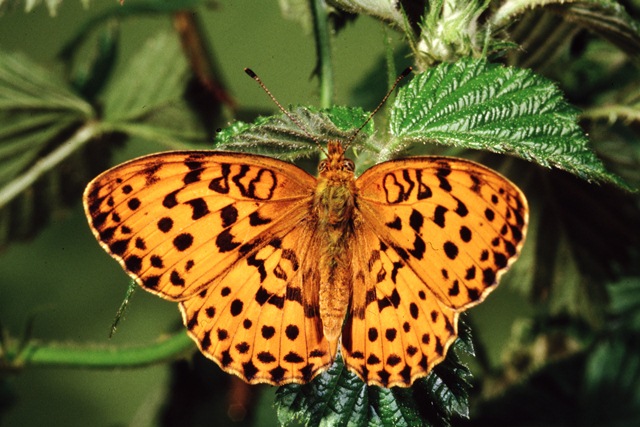 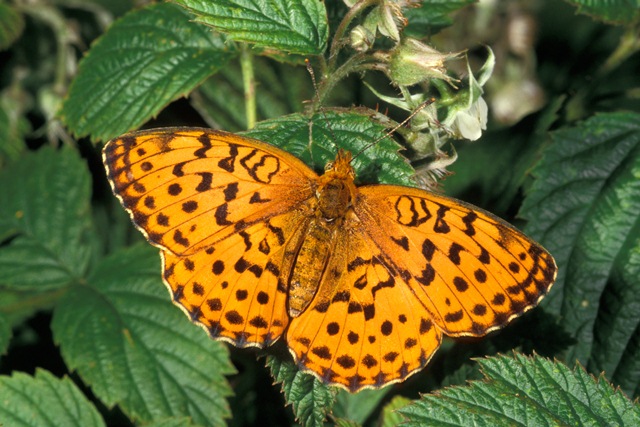 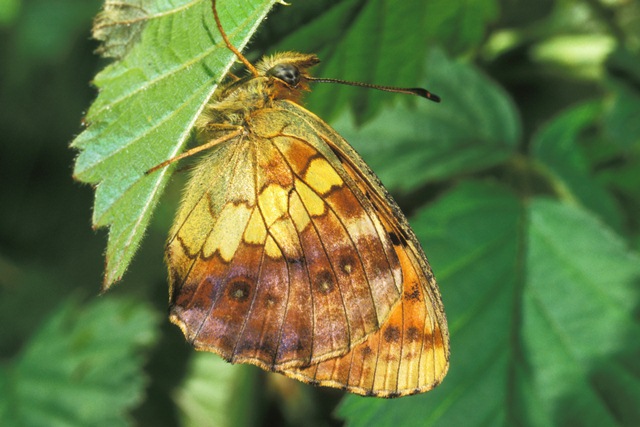
Photographs: Frits Bink ©.
Medium-sized, wing length 23 (21-25) mm. A recent new member of the Benelux fauna, it appeared in 2000 in Luxemburg, in 2006 in the south of Wallonia and in the Netherlands one butterfly was seen in 2011.
Butterfly is on the wing from end-June until end-July. The species is known from sub-continental to continental climates, amplitude 8 to 17. Required heat sum 900°d and maximum tolerated 2000°d. Corresponding climate windows 26 and 38 weeks.
In the 1970’s it was noticed that, in northeast France, the species extended its distribution, the valley of the Meuse provided a good corridor towards Belgium. The neglected shrub vegetation of brambles along roadsides, wood edges and steep hill slopes provided a habitat for this species.
Ecologically this species has much in common with Brenthis ino; In the Ardennes the latter species inhabits cool and humid sites, whereas B. daphne inhabits warm and dry sites. It is an easy species to breed and thus suitable for butterfly houses, one of the useful features being that the eggs of B. daphne are much bigger than those of B. ino and thus the newly hatched larvae are much sturdier.
Ecological characteristics
Behaviour over time
Overwintering: egg (the larva in the egg shell is already visible 17 days after the egg is laid).
Reproduction: oviposition starts after 8-1 days when the body contains 32 (27-35) eggs. Potential production 4 times as much. The butterfly produces during two weeks 11 (6-35) eggs per day.
Larval feeding periods: 58 (51-65) days in the period from early-April until early-June.
Generations: one.
Spreading of risk: not observed.
Life cycle: egg 37-40 weeks; larva 8 weeks; pupa 22 (18-26) days.
Life span of adult: long, 4 weeks.
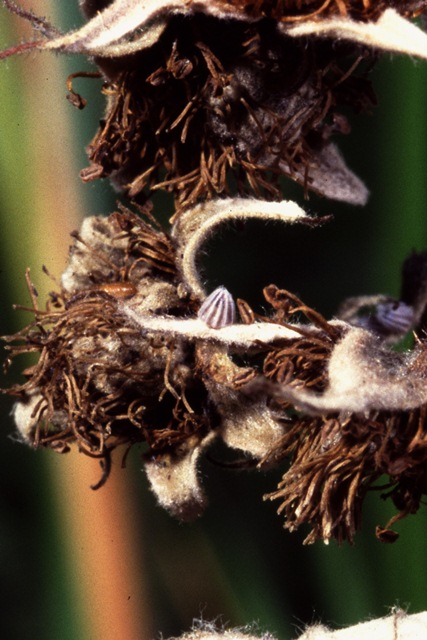 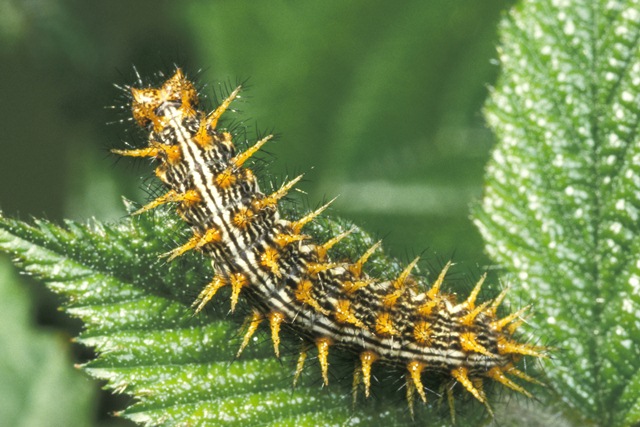
Photographs: Frits Bink ©.
Behaviour in space
From stay-at-home to migrant: stay-at-home, spatial requirement modest.
Finding a mate: patrols a little, the species lives colonially and thus the females are encountered easily.
Orientation in the landscape: shrub vegetation along hedges, woods and walls.
Oviposition: individually on the sepals of wilted flowers, which drop into the litter layer in winter.
Defence
Threats from other organisms: larva is armoured by spikes and the pupa has bright golden spots that may mislead avian predators.
Threats from the environment: rather tolerant of heat and drought, however the butterflies hide most of the day in a bramble bush.
Feeding habits
Adult: nectar of flowers, in most cases of the host plant.
Larva: the newly hatched larva depends fully on the young shoots in spring, later in the season the larva feeds also on mature leaves, upon which the larvae may bask.
Larval foodplants
Plant species: Rosaceae, Rubus fruticosus and all related species, also Rubus idaeus.
Journal
Breeding experiment based on specimens from Aosta, Italy, provided by Jos Stevens:
31 July 1985: receipt of eggs.
2 August: larvae inside the egg shell developed.
25 August: larvae had shrunk and taken up only three-quarter of the egg shell volume.
Overwintered in a cool place outside.
9 March 1986: taken indoors, some larvae stirred inside the egg shell, eggs sprayed.
11 March: four eggs hatched.
15 March: nearly all eggs hatched, two larvae started to eat the shoot of a raspberry (Rubus idaeus). Larvae rested on an old wilted leaf.
19 March: larvae fed only on the very young leaves, basked when sun shined.
23 March: larvae in moult L1-2.
5 April: one larva in L1, two in moult L2-3, nine end second instar.
17 April: two larvae in moult L3-4.
20 April: two larvae in fourth instar, drop when disturbed.
24 April: food-plant changed, Rubus fruticosus was preferred to R. idaeus.
4 April: biggest larvae nearly full grown, the smallest one in moult L4-5.
5 May: first pupa, two prepupae.
15 May: four pupae, three prepupae, two larvae feeding.
19 May: last larvae pupated.
21 May: two adults appeared, males.
28 May: first female hatched.
2 June: female with enlarged abdomen made egg laying movements. Other females reacted towards approaching males by lifting their abdomens, the wings flat and fluttering.
4 June: first eggs were laid, five on old flowers, one on a leaf.
9 June: second female started egg laying, thus nine days prior to oviposition.
14 June: last pupa hatched.
21 June: eggs collected, in the older ones the young larva already visible, so their development took 17 days.
Overwintered indoors.
15 March 1897: eggs were sprayed and hatched after a warm day, temperature up to 32°C.
Table 114-1. Results of dissections

Table 114-1a. Oviposition sequence

Table 114-2. Collection and observation localities
F, Lorraine, Rupt devant Saint-Mihiel, 280 m, 48° 53’ 01”N – 5° 24’ 10”E; 28 June 2006.
Fig. 114-1. Brenthis daphne, designed phenogram.
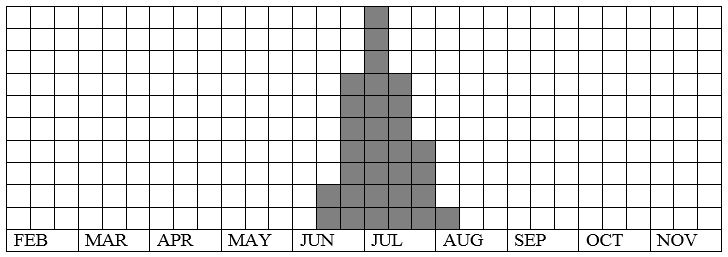
Fig. 114-2. Brenthis daphne, habitat characteristics.
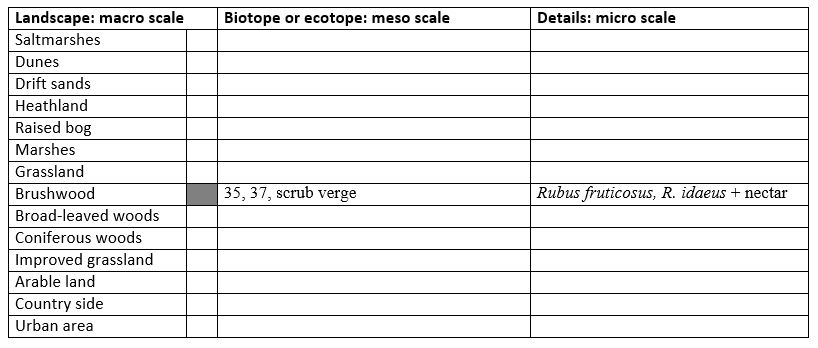
Fig. 114-3. Brenthis daphne, climate matrix, heat-sums 900 - 2000°d.

|











